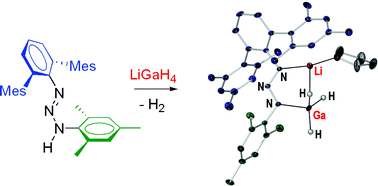The sterically bulky triazenes DitopN3(H)pTol, DitopN3(H)Mes, DmpN3(H)pTol and DmpN3(H)Mes, where Ditop = 2,6-di-p-tolylphenyl, Dmp = 2,6-dimesitylphenyl, pTol = p-MeC6H4 and Mes = 2,4,6-Me3C6H2, have been prepared. The reactivity of these triazenide precursors with LiAlH4 and, in the cases of DmpN3(H)pTol and DmpN3(H)Mes, LiGaH4, with diethyl ether as the solvent, has been examined. All reactions were undertaken in a 1:1 ratio giving rise to a variety of aluminium and gallium complexes that either incorporate LiH with a metal to triazenide ratio of 1:1 or generate ‘LiH-free’ aluminohydrides with aluminium to triazenide ratios of 1:1 or 1:2 dependant on triazenide bulk. Increasing triazenide bulk from DitopN3pTol through to DmpN3Mes results in a transition from complexes of structure [{Li(OEt2)(μ-H)(μ-L)AlH (μ-H)}n] (L = triazenide ligand; n = 2 DitopN3pTol, n = 1 DitopN3Mes, DmpN3pTol), to bis(triazenide) monohydride complexes [AlH(L)2], through to monotriazenide dihydride complexes [AlH2(L)]. By contrast, both DmpN3(H)Ar (Ar = pTol or Mes) triazenides react with LiGaH4 to afford the monomeric, lithium hydride containing, complexes [Li(ether)(μ-H)(μ-L)GaH2] (L = triazenide, ether = OEt2 or THF). The molecular structures of [AlH(DitopN3Mes)2], [AlH(DmpN3pTol)2], [AlH2(DmpN3Mes)(THF)] and [Li(THF)(μ-H)(μ-DmpN3Mes)GaH2] are reported, as well as the structure of the triazene DmpN3(H)Mes which exists in the E-syn isomeric form in the solid-state.


 Please wait while we load your content...
Please wait while we load your content...